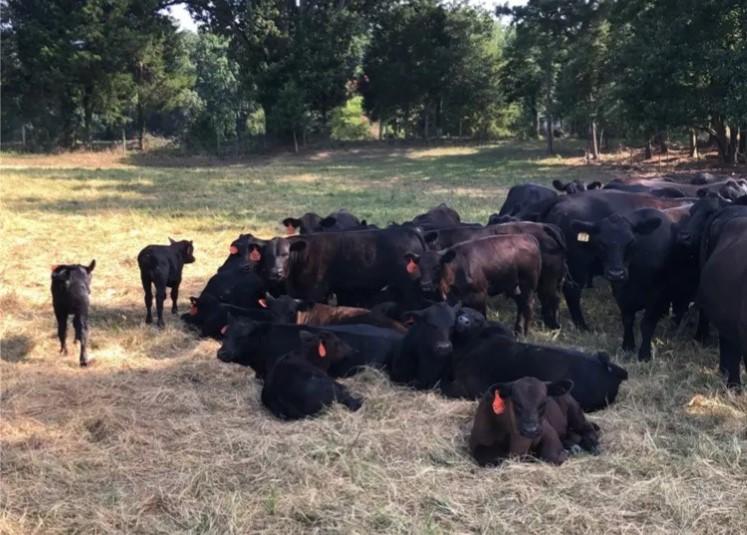Managing Bloat in Pastured Cattle
What is bloat and why does it occur?
The rumen is the largest compartment of the ruminant stomach and is home to a host of microbes, such as bacteria, protozoa, and fungi, which break down feeds through a process called microbial fermentation. This fermentation process allows ruminants to digest and utilize fibrous plant products that cannot be utilized by other species. While the main products of microbial fermentation are fatty acids that can then be utilized by the animal to support energy and protein metabolism, gases, such as carbon dioxide, methane, hydrogen, and ammonia, are also produced as byproducts. The majority of these gases are normally released from the rumen through a process called eructation, or belching. Bloat occurs when these gases become trapped in the rumen, resulting in ruminal expansion that puts pressure on the lungs, prevents appropriate respiration, and, if severe, can lead to death.
There are two types of bloat. The first and most common type is called primary, or “frothy” bloat. Frothy bloat results when the gases become trapped in the liquid or semi-liquid portion of the ruminal contents, forming a foam, and are unable to escape through normal belching. The second, and less common type is called secondary, or “free gas”, bloat, which results from a physical obstruction in the esophagus or a dysfunction of normal ruminal contraction processes.
How is bloat recognized?

Bloat is detected through visual observation. When looking at the left flank area of a bloated animal, the normal contour at the paralumbar fossa becomes convex (protrudes outward), rather than concave (curves inward). Bloated cattle may indicate their discomfort by stomping their feet or kicking at their sides. In severe cases, they will exhibit labored breathing with their mouth open and tongue out, signaling respiratory distress, and may suddenly collapse and die. If untreated, cattle can die within 3 to 4 hours after the onset of bloat.
What circumstances contribute to the development of bloat?
Bloat develops differently for every animal due to unique interactions between factors related to the animal, the rumen microbiome, and forage chemical properties.
Certain forages have a greater bloat-potential than others. Some legumes, including alfalfa and most clovers, contain high levels of soluble protein and digest rapidly in the rumen, giving them a high bloat-potential. However, other legumes, such as birdsfoot trefoil, have a lower bloat-potential due to their relatively high concentrations of condensed tannins, which help to prevent the formation of the foam that inhibits normal belching and gas escape from the rumen. Wheat pastures also have a relatively high bloat-potential. The greatest risk for bloat occurs when cattle are first given access to high bloat-potential forages. Cattle can adjust to these forages after they consume them for several consecutive days.
Weather can also play a role in the development of bloat. Conditions that promote lush forage growth, such as cooler nighttime temperatures combined with timely rains, can increase risk for bloat on high bloat-potential forages.
How can bloat be prevented?

There are several products on the market that can be used to help prevent boat. These products normally contain an antifoaming compound called poloxalene. To an extent, condensed tannins and ionophores (e.g., monensin) can also help reduce incidence of bloat. For adequate effect, these products must be consumed on a daily basis throughout the high-bloat-risk period.
Although there are several commercial products available, careful pasture management is usually a sufficient, more economical approach to preventing bloat. Below are a few pasture tips to prevent or reduce the development of bloat.
- Avoid turning cattle out onto high-risk pastures on an empty stomach. Allow animals to consume hay or grass pasture before turning them out to high-risk pasture. For this reason, afternoon or evening turn-out is often best.
- Avoid turning cattle out to high-risk pastures when leaves are damp from dew or rain because moisture increases rate of digestion and encourages higher levels of consumption (i.e., over-eating).
- Offer access to smaller strips of the high-risk pasture each day, while still allowing access to low-risk pasture.
- Observe animals closely for signs of bloat during the first week after turn-out to high bloat-potential pasture. Mild bloat is common, but watching for signs of moderate to severe bloat is critical for administering prompt treatment.
- Observe cattle closely for signs of moderate to severe bloat during wet weather, particularly in the spring or after periods of drought-stress during the late summer or early fall.
- Avoid frequent changes from high-risk to low-risk pastures. Doing so prevent the rumen microbes from adapting to the high bloat-potential forage.
How is bloat treated?
As mentioned previously, severe bloat can lead to death if not treated quickly. Symptoms can sometimes be relieved through proper use of a stomach tube, administration of an antifoaming agent, or use of a trocar. Consult a veterinarian to ensure proper treatment for bloat.
For Additional Reading
- Constable, P.D. 2015. “Bloat in Ruminants”. Merck Veterinary Manual. https://www.merckvetmanual.com/digestive-system/diseases-of-the-ruminant-forestomach/bloat-in-ruminants.
- National Research Council. 2016. Nutrient Requirements of Beef Cattle. 8th Revised Edition. Natl. Acad. Sci., Washington, DC.
- Rasby, R.J., B.E. Anderson, and R.F. Randle. 2010. “Bloat Prevention and Treatment in Cattle”. University of Nebraska – Lincoln Extension. https://extensionpublications.unl.edu/assets/pdf/g2018.pdf.
This article appears in August 2021, Edition 2, Cattles Tales Livestock Newsletter
